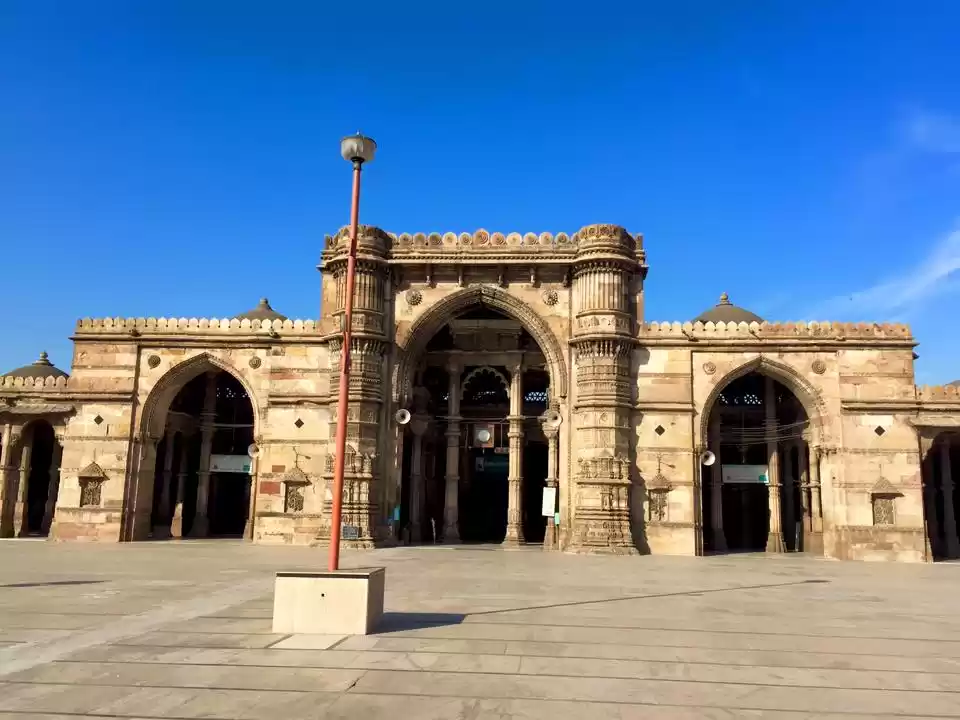
It had been two months in Ahmedabad, and I had been travelling extensively across Gujarat in these two months but somehow kept postponing my plans to explore Ahmedabad itself. In these 2 months apart from malls and restaurants, the only other place I had been is the Sabarmati Ashram. Ahmedabad is the first UNESCO World Heritage city of India and there is no dearth of places and legends in this city to keep a history lover like me intrigued. But things got busy and it came down to my last day at Ahmedabad before I could explore the old city.
The day started at 6 AM, I boarded a BRTS bus from Star Bazar bus stop and dropped at Lokmanya Tilak Baug stop, the first stop after you cross the Sabarmati river. The river basically separates the heritage part of Ahmedabad from its extravagant, modern part on the opposite bank. I walked to the Lal Darwaja market. In the last 2 months, this had been my favourite spot as this place is one of the few pockets in Ahmedabad where you can find kebabs, pakodas and other nonveg delicacies without burning a hole in your pocket. The rest of Ahmedabad is dreadful for non-vegetarians - just to mention, fast food chains like Subway, PizzaHut and Dominos Pizza have opened only veg outlets with some even going a step ahead to offer Jain food. In the evening, the market is a farrago of shrieking horns, namaz from the nearby mosque and a bustling crowd. Now, in this early hour, the place looked deserted and movement was restricted around an ancient Bhadra Kali Maa temple located within the ramparts of the Bhadra Fort. I started my heritage walk through the lanes of old Ahmedabad from this temple.
Just behind the temple is the remnant of the ancient Bhadra Fort - a citadel which once housed royal palaces, beautiful gardens and mosques. The fort was and its surrounding walls and gates were completely obliterated over centuries and very recently, thanks to the renovation and restoration initiatives taken by the Amdavad Municipal Corporation and Archeological Survey of India, some parts of the fort has been recovered. There is a clock tower which was established in the mid-nineteenth century. A custom of illuminating a kerosene lamp on the fort was replaced by an electric bulb in what was the first electrical connection of Ahmedabad city. As part of the renovation measures, a small museum has been set up in the 2nd floor of the fort.

After exploring the Bhadra Fort, I started to walk towards the Jami Masjid. On the way, I passed through the iconic Teen Darwaza gateway. This dilapidated gateway is associated with many historic events and legends. There is a progressive decree or farman inscribed by Maratha governor Chimnaji Raghunath in 1812 declaring equal rights to women in the inheritance of ancestral property for both Hindus and Muslims.
Walking ahead on the same road, I reached the Jama Masjid. This landmark mosque was built during the reign of Ahmed Shah and is one of the largest mosques of its time. It was originally intended for private use of the royal family. The mosque premise has three entrances, a large open courtyard with collonades on the sides and a tank in the middle. The main entrance of the mosque is flanked by two columns which are the remnants of the two 'shaking minarets' which were destroyed by the earthquakes of 1819 and 1957. Since I went there just a few days before Eid-ul-Fitr, the mosque was being prepared for the mass gathering on the eve of Eid. In the picture below, you can see the green frames being erected in the courtyard to make arrangements for shade.

The mosque has excellent stone scrollwork on its walls and pillars. Particularly, the carvings of trees on the front walls are strikingly beautiful. The mosque has a large open prayer room with carpeted floors, structured columns and beautiful domes. There is a mihrab in the mosque which declares its year of completion.


After spending about 20 mins here, I walked to the Manek Chowk. This place comes alive as the night sets in and is a popular late night food joint in the city. People from all age groups throng to this place especially on weekend nights to savour pav bhaji, sandwich, kulfi, faluda and other delicacies. However, amidst this hustle and bustle, just behind where the night market is set up is the " Badshah no Hajiro" where emperor Ahmed Shah is laid to rest along with his son and grandson in a modest mausoleum quite contrary to his extravagant lifestyle and the other ostentatious monuments built by him. Here the locals have accorded him the status of a saint or pir and his mausoleum is now called the dargah of Ahmed Shah and people offer chadar on his tomb. Naubat, a traditional rendition of drums and shehnai, played by a group of musicians over generations continues till date and there is chamber over the entrance to the tomb where the ninth generation of the musicians have kept the tradition alive.

On the opposite side of the road is the " Rani ka Hazira " - the burial place of the royal ladies. It's an open courtyard enclosed by perforated, latticework walls and open colonnades. The principal tombs include the black marble tombs of Bibi Mughli and Bibi Mirki. When I reached there, it was locked and some young boys were playing in the vicinity. One of them went and called a man in his sixties who appeared with the keys of the mausoleum and allowed me inside. The most striking features are the lattice walls and beautiful stone carvings on the blind doors.
My next stop was on the complete opposite side of the Bhadra fort close to the banks of river Sabarmati - the Shahi Jam-e Majid. Consecrated during the reign of Ahmad Shah I, it is the oldest mosque in Ahmedabad and was used for private worship of the royal family.

From here I hired an autorickshaw to the famous Sidi Saiyyed mosque. It's again another ancient mosque reminiscing its days of glory. However, there is a special attraction here - the iconic Sidi Saiyyed ni Jalli, the latticeworks on the rear arches of the mosque. The famous latticework of a motif of an intertwined tree on one of these arches has been selected as the logo of Indian Institue of Management, Ahmedabad, the premier most management institute of the country. It is a testimony and an apt tribute to the outstanding craftsmanship and excellence of the sculptures who have produced this marvel. It was an absolute delight for me to see this piece of art and I spent quite some time adorning and clicking pictures of it. The tomb of Pir Siddi Sayyed is just outside the mosque under a tree. Like the other mosques in the city, this one was also being decked up for the Eid celebrations.
Just beside the Sidi Saiyeed mosque is the New Lucky Restaurant. It is a one of its kind place where the owners have constructed the restaurant without tinkering with the tombs that once existed at the very place where the restaurant stands today. This eerie place is frequented by visitors and is famous for its unique concept - dining with the dead. This place was in the top echelon among places where I wanted to visit in Ahmedabad. I mean its just too weird not to raise curiosity.

Tables are lined up beside the tombs and people dine here as if completely oblivious to the fact that its dead people buried right next to their dining tables. I still can't comprehend the thought process of the person who initially conceptualized this idea. Anyways, it has earned him quite some bucks so fair enough.

My final stop in the heritage tour of the UNESCO World Heritage City was the Hutheesing Jain temple. Although constructed much later in comparison to the other ancient sites discussed above, nevertheless, it is one of the major attractions of Ahmedabad. It is a double storied temple dedicated to the Jain Tirthankars, primarily to the 15th Tirthankara - Lord Dharmanath. The temple also has a unique Kirti Stambha. It was a well managed and serene place. I was too tired by the time I reached the Hutheesing Jain temple so I returned without spending much time here.

So this brings me to the close of an exciting morning in which I visited forts, mausoleums, temples, restaurants, mosques, everything.!!! Walking through the alleys of old Ahmedabad and connecting the dots of the remnants of the monuments, I tried to envision the complete picture of the illustrious walled city. Much like the city he built, the legacy of Sultan Ahmed Shah lies fragmented and strewn over the pages of history books and he is remembered not as a conqueror who consolidated the sultanate or as a connoisseur of architecture who built the extravagant monuments but as a saint, a Pir who rests in a decrepit chamber along with his successors. Hope you liked this post, please share your views, comments and feedback in the section below. Travel & Spread Love..!!!
































